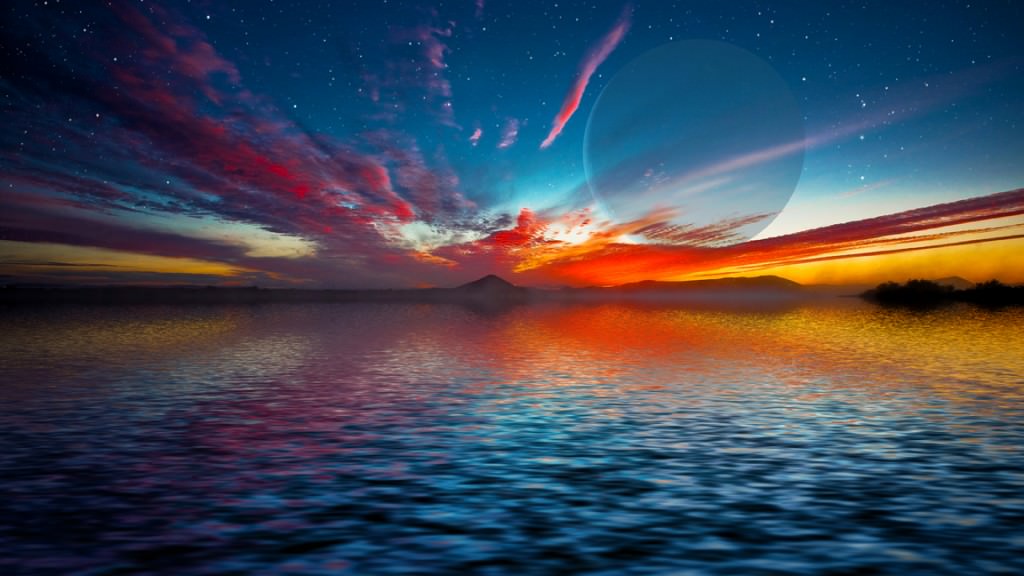Our planet’s oceans generate tell-tale light signatures when sunlight reflects off them. Exoplanets with significant ocean coverage may do the same. Can we use the Earth’s reflectance signatures to identify other Earth-like worlds with large oceans? We should be able to, eventually.
A new study examined light signatures reflecting off of Earth’s oceans and explored their flux and polarization. The researchers modelled two Earths: a dry planet and a wet planet with Earth-like clouds and atmosphere. Then they simulated how light would reflect from those planets in different conditions.
They found that only an ocean can cause the polarization of light to dip in specific ways. The study is titled “Ocean signatures in the total flux and polarization spectra of Earth-like exoplanets. ” The journal Astronomy and Astrophysics will publish it, but it’s currently available online at the pre-press site arxiv.
org. The authors are V. J.
H. Trees and D. M.
Stam. Trees is from the Royal Netherlands Meteorological Institute, and Stam is from the Delft University of Technology. Scientists have found water vapour on exoplanets, but it’s detected spectroscopically when the planet is in front of its star and the starlight passes through the atmosphere.
Those observations revealed the molecular signature of water, but there’s currently no way of knowing if there’s an ocean. “… actual observations of liquid water oceans are only possible using a direct detection of the starlight that is reflected by the planet,” the paper states. Some scientific estimates show that up to one-quarter of known exoplanets have oceans, though much of that water may be in subsurface oceans.
In our Solar System, only planet Earth has surface oceans. Multiple moons in the Solar System have subsurface oceans, and some of the dwarf planets probably do too. An artist’s view of countless exoplanets.
Some of the thousands of exoplanets we’ve discovered should have oceans. Credit: NASA/JPL-Caltech We’re not close to detecting subsurface oceans on exomoons, but as telescope technology advances, we may be able to detect oceans on planets similar to Earth. As the authors of this paper write, “Numerical simulations of starlight that is reflected by Earth-like exoplanets predict habitability signatures that can be searched for with future telescopes.
” The researchers computed three things in their numerical exoplanet simulations: total flux (F), polarized flux (Q) and degree of polarization (Ps). They modelled the oceans in a particular way. “The oceans consist of Fresnel reflecting surfaces with wind-ruffled waves, foam and wave shadows, above natural blue seawater,” they explain.
Fresnel reflecting is when the reflected light is in the same plane as the incident light. It’s also called parallel polarization, named after Augustin-Jean Fresnel. He invented a lens used in lighthouses that focuses light into a narrower beam.
Measuring the polarization of light from oceans is important because starlight isn’t expected to be polarized. Also, while light signals degrade with distance, the degree of polarization doesn’t. Unfortunately, astronomers can’t measure ocean-reflected polarization yet.
“Current ground-based and space-based telescopes are not capable of measuring the polarized light that is reflected by Earth-like exoplanets,” the authors explain. But that will change. The upcoming European Extremely Large Telescope (E-ELT), and the Large Ultraviolet Optical Infrared Surveyor (LUVOIR), a space telescope concept being developed by NASA, will both be able to measure polarized light.
Numerical models like the ones in this study will be used to design the instruments and observation procedures needed to sense the polarization of light reflected by exo-oceans. One of the main takeaways from this work concerns the degree of polarization or Ps. The image below compares the Ps for cloud-free dry planets vs cloud-free ocean planets.
This figure from the study compares the degree of polarization of reflected starlight from cloud-free dry planets vs. cloud-free ocean planets. In the left column, as is surface albedo, where 0.
0 and 0. 1 are dark surfaces and 0. 8 is a bright surface.
In the right column, v is wind speed. 13 m/s is about 47 km/h, and 1 m/s is about 3. 6 km/h.
Each separately coloured line is a different phase angle. Image Credit: Trees and Stam, 2022. The main takeaway is that Ps only dips in certain circumstances, which can be measured.
As the authors point out, “Dips in Ps are only observed for ocean planets and only when the glint is cloud-free. ” That’s a simplified summary of their results, but it shows that they’re onto something. If—or hopefully when—we discover an exoplanet with an ocean, it’ll be a landmark event.
The space science community is pretty confident they’re out there and hold a strong possibility of supporting life. Hints of exo-oceans turn up when scientists measure an exoplanet’s density vs its size. But as it stands, there’s no way of knowing for sure if we’re detecting a surface ocean.
These researchers have been working on the problem of detecting exo-oceans for a while now and have published other papers tackling the issue. If their simulations are correct, we may be developing a reliable way of detecting ocean worlds at great distances. The E-ELT is due to see first light around 2027 and it will be capable of detecting polarized starlight reflected from oceans.
Maybe we’ll have our first confirmed ocean exoplanet not too long after. More: Research Paper: Ocean signatures in the total flux and polarization spectra of Earth-like exoplanetsUniverse Today: A Technique to Find Oceans on Other WorldsUniverse Today: Deep Down in Ocean Worlds, it’s Difficult to Tell Where the Oceans End and the Rock Begins The post “Wind-Ruffled Waves, Foam and Wave Shadows, Above Natural Blue Seawater. ” This is how we’ll Spot Exoplanets With Oceans appeared first on Universe Today.
.
From: universetoday
URL: https://www.universetoday.com/156054/wind-ruffled-waves-foam-and-wave-shadows-above-natural-blue-seawater-this-is-how-well-spot-exoplanets-with-oceans/



